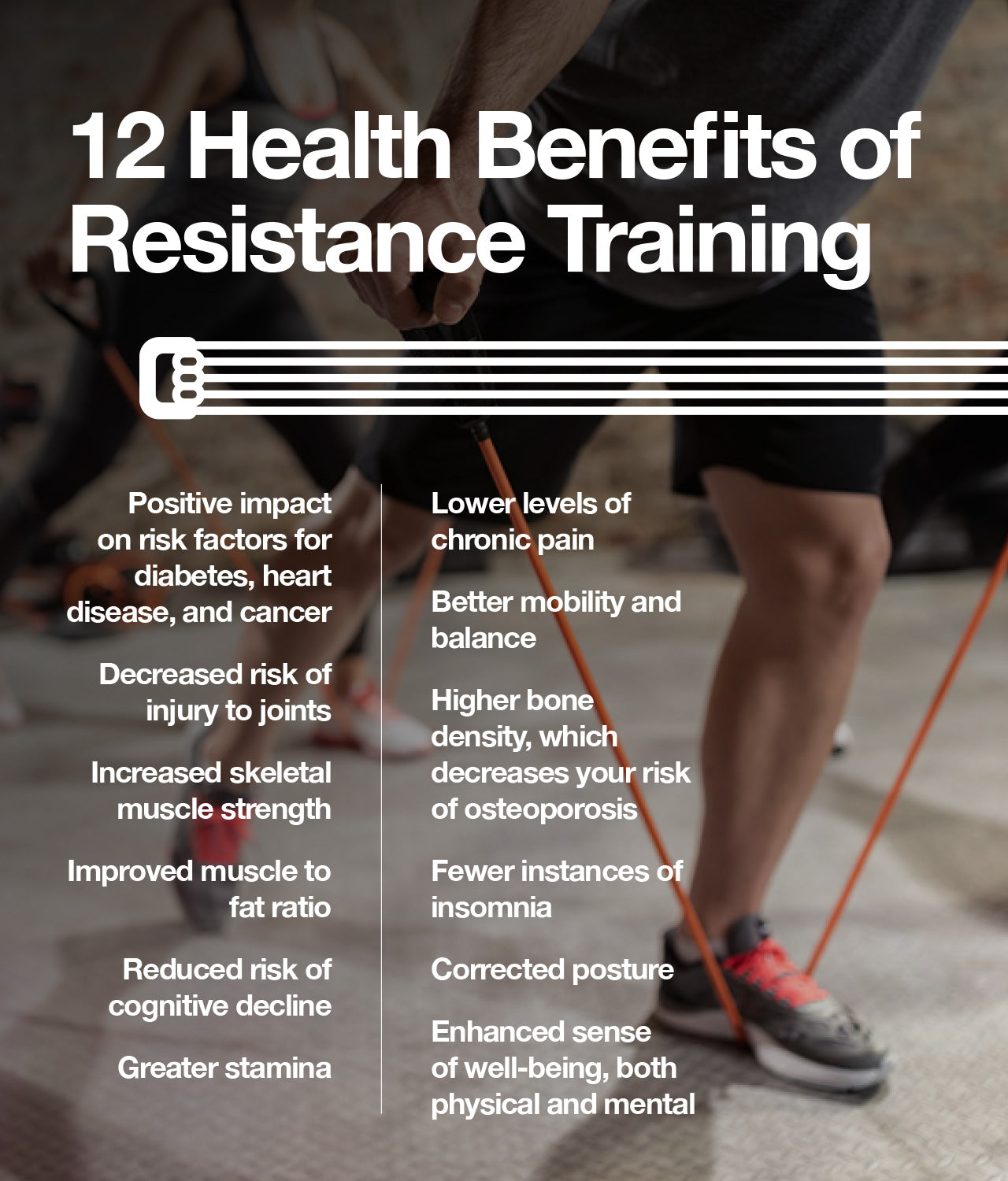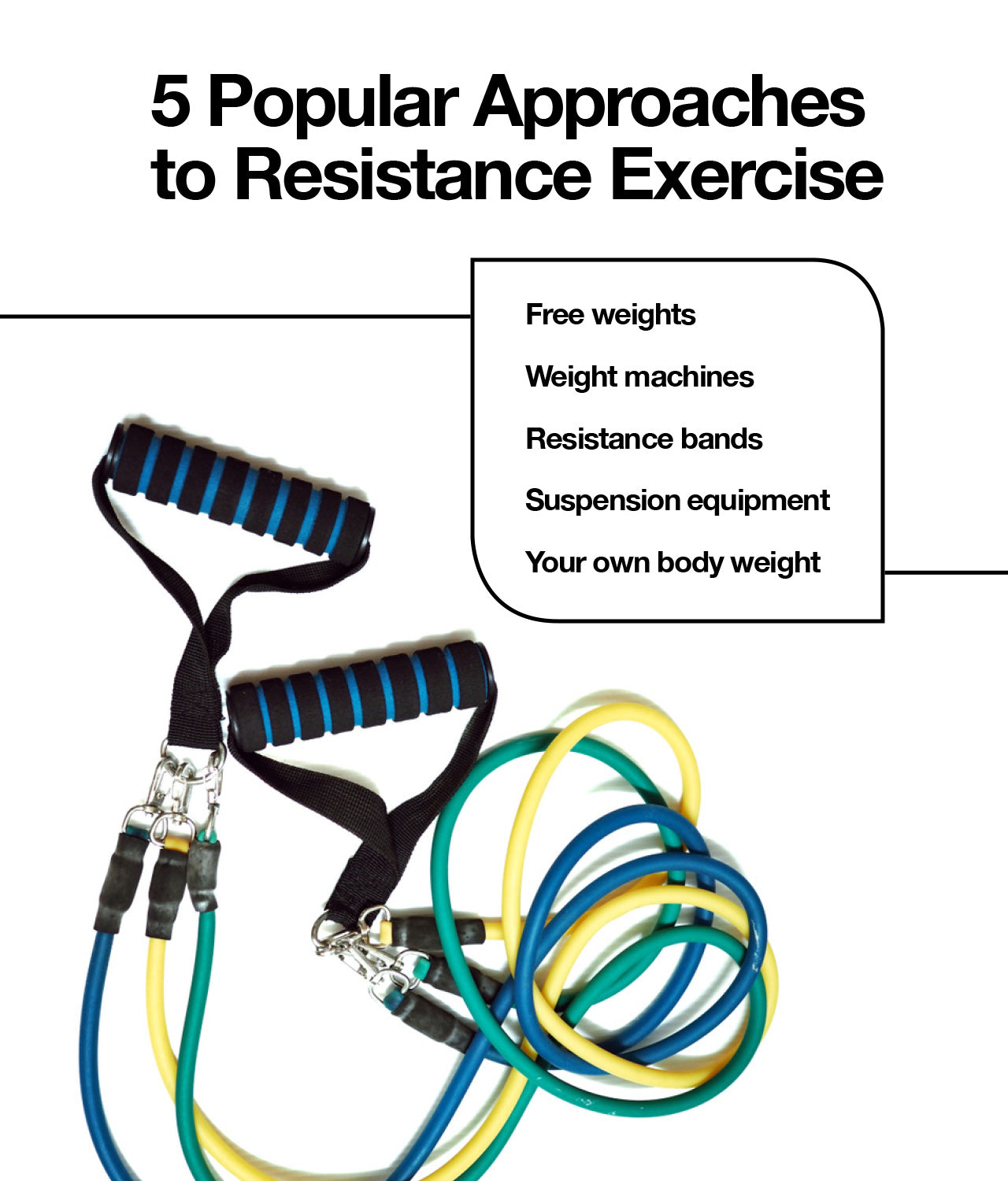Resistance Exercise: Muscle Strength, Muscle Mass, Muscle Definition
 By: by Amino Science
By: by Amino Science

Resistance exercise, often referred to as strength training or weight training (though you can make major strength gains using only your own body weight), is a broad term that encompasses any physical activity involving the use of resistance to muscular contractions in order to increase muscular strength, decrease body weight, and improve your overall quality of life.
Resistance training exercises work the major muscle groups in the body by asking them to overcome resistance force. Push-ups are a classic example of a bodyweight resistance exercise. When you commit to a resistance exercise training program—and execute the movements with good form—you can see impressive improvements when it comes to building muscle.
While there are many benefits of resistance training, including better joint function, increased bone density, and enhanced muscle, tendon, and ligament strength, a well-rounded training program should also incorporate aerobic exercise that targets the health of your heart and lungs as well as flexibility and balance exercises to expand both your range of motion and your control in positions at the extremes of that range.
Before helping you compare resistance-training approaches to determine which is the best fit for you, let's take a moment to go over the benefits of resistance training.
How Resistance Training Benefits Your Health
Studies show that resistance exercise can improve your health in a number of significant ways.

According to a review published in Preventative Medicine: "Research demonstrates that resistance exercise training has profound effects on the musculoskeletal system, contributes to the maintenance of functional abilities, and prevents osteoporosis, sarcopenia, lower-back pain, and other disabilities."
The authors of the review also note that resistance training has been found to positively influence risk factors for diabetes, heart disease, and cancer, such as:
- Insulin resistance
- Resting metabolic rate
- Glucose metabolism
- Blood pressure
- Body fat
- Gastrointestinal transit time
And they found that all these benefits of resistance training can likely be achieved through two 15- to 20-minute training sessions each week—quite a minimal time investment for such a considerable health payoff!
Additional benefits associated with resistance exercise include:
- Decreased risk of injury to joints
- Increased skeletal muscle strength
- Improved muscle to fat ratio
- Reduced risk of cognitive decline
- Greater stamina
- Lower levels of chronic pain
- Better mobility and balance
- Higher bone density, which decreases your risk of osteoporosis
- Fewer instances of insomnia
- Corrected posture
- Enhanced sense of well-being, both physical and mental
5 Different Types of Resistance Exercise
When it comes to resistance-exercise programs, there are numerous options out there sure to appeal to individuals with a wide range of fitness levels and physical activity preferences.

If you're new to resistance training, you may find it beneficial to work with a personal trainer. There are also many online resources that can help you find appropriate warm-up exercises, build muscular strength, work toward healthy weight-loss goals, and effectively target different body parts.
Some popular resistance-training approaches include:
- Free weights: This is the category for classic strength-training tools like the dumbbells and barbells you need to execute a bench press. Kettlebells, medicine balls, and sandbags belong here too, as do any other weights you lift without guidance from a machine.
- Weight machines: These can be more approachable if you're new to lifting weights, though some experts feel they're less effective for building overall muscle strength than free weights are since they work one muscle group at a time. Examples of common weight machines include the seated leg press, pull-downs, and lever triceps dips.
- Resistance bands: These deceptively simple tools (they're just giant rubber bands) are portable, adaptable to practically any workout, and can be immensely challenging. When stretched, they offer continuous (and adjustable) resistance throughout a workout.
- Suspension equipment: This category includes simple hanging bars that allow you to do pull-ups and chin-ups, as well as machines that use counter-balanced weights to make those movements easier.
- Your own body weight: Hands-down the most accessible form of exercise, since all you need is your own body. You can use bodyweight exercises like squats, push-ups, and chin-ups to train both your upper body and your lower body.
Which Type of Resistance Exercise Is Best for You?
Increasing muscle strength is a primary goal of resistance exercise. But what if your goal is to increase muscle strength without increasing mass? For example, extra body weight is a liability to a distance runner, but increased muscle strength is an asset. A football player on the other hand not only wants to get stronger, but also wants to get bigger. A bodybuilder wants to increase muscle protein mass while minimizing body fat and muscle glycogen in order to get the “ripped” look.
Just as your training will differ depending on your performance goals, so, too, will your optimal nutrition program, including the formulation of your essential amino acid (EAA) supplements, which will help you build muscle fast.
Here are three questions to consider when deciding which resistance-training program, as well as dietary and supplement supports, will be the best match for you and your goals.

1. Do You Want to Build Muscle Mass?
It's a common misconception that lifting weights will make you bulkier. The response of the muscles to resistance exercise and EAA supplementation depends on both the type of workout and the amount of calories you consume. Performing a few heavy lifts, for instance, primes the muscle to respond to essential amino acids with both an increase in strength and muscle mass.
When you do multiple lifts with a relatively small weight, muscle protein turnover will also be stimulated to a greater extent when EAAs are taken in conjunction with the workout, but there will be a closer balance between synthesis and breakdown, and strength will increase without much change in muscle mass.
It’s easy to see how the type of workout can affect the desired outcome: strength, or strength plus mass.
Calorie Intake Is Key
Consuming extra calories while supplementing with EAAs will also affect your body’s response to resistance exercise. An EAA supplement has a very small caloric value, and when taken in conjunction with resistance exercise imparts a greater effect on strength than on muscle mass. But if you increase the amount of calories you ingest while also taking EAAs, the size of your muscles will increase alongside strength. Of course, lifting heavy for a few reps will have much more of a mass effect than lifting light for multiple reps.
How Carbs Impact Muscle Mass and Definition
The non-protein component of an EAA supplement also affects the ultimate impact of exercise on strength and mass. If EAAs are taken with carbohydrate, the insulin response to carbohydrate will enhance the EAA effect on muscle protein synthesis, suppress protein breakdown, and contribute to a greater net gain of muscle protein mass. In addition, some of the carbohydrate will be stored in the muscle as glycogen, and water will attach to the glycogen in its storage form in muscle. As a result, muscle size will increase even more than from the gain in net protein. However, water and glycogen storage will lessen muscle definition.
If you are trying to increase muscle mass and strength and are not particularly concerned about muscle definition, then you should take carbohydrate along with EAAs before and after a workout. If you are a bodybuilder and want to get bigger but also want muscle definition, then it is best to limit carbohydrate intake. This is true not only with regard to EAA supplements, but also with your basic diet. If mass and strength with definition is your target, then take only EAAs before and during the workout, and eat a diet made up of largely protein and fat. This will minimize the storage of glycogen and water in the muscle, both of which impair muscle definition.
Muscle Definition with EAA Supplementation
If muscle strength and definition without much increase in mass is your specific goal, I recommend taking EAAs by themselves before and after your workout. By performing a large number of repetitions with a relatively low weight, the muscle gain will be less than the muscle gain stimulated by fewer lifts with heavy weights. It may be inevitable that you gain some muscle mass along with your strength gains, but if you take EAAs without carbohydrates before and after workouts, the major impact will be on strength.
2. Do You Want to Lose Weight?
Many people believe that cardio is the most effective kind of exercise for weight loss, but studies clearly show that strength training can be at least as effective, if not more effective, when it comes to helping you lean out.
New research from the American College of Sports Medicine (ACSM) offers clear insight into how resistance exercise can help you lose weight faster than moderate cardio can. One reason for this, the study authors note, is that building muscle boosts your metabolism, which can speed up your weight-loss efforts.
People also find it easier to make time for a quick resistance-training session than for an hour-long treadmill workout. This makes it more likely that individuals will adhere to a consistent physical activity program, which is key for weight-loss results.
A Manageable Time Commitment
The ACSM study indicates comparable results for two strength-training sessions weekly versus three strength-training sessions weekly. Shooting for just two workouts per week is a manageable way to introduce a physical activity training program into your schedule.
To maximize your results, you'll want to choose workouts that target all of your major muscle groups: upper body, lower body, and core.
The Progressive Overload Principle
When beginning a strength-training program, many people have questions about how much weight they should lift. The American College of Sports Medicine recommends selecting a weight (or level of resistance) that requires between 60% and 70% of your maximal effort.
A helpful trick for gauging that is to settle on a weight at which you can complete 10 repetitions with proper form—your posture doesn't begin to slip, you're not using momentum to make it easier, and so on. The goal is to choose an appropriate weight or resistant force that requires strenuous effort but doesn't strain you to the extent that you compromise your form.
To continue to reap the benefits of strength training, including weight loss, you need to consistently reach the point at which it would be difficult for you to complete another repetition. This is the principle of progressive overload: regularly adjusting training variables such as the number of sets and repetitions you complete, or the weight you use, in order to continue to grow stronger and fitter.
When the 10-rep set you began with starts to feel too easy, you'll increase your set to 15 reps at the same weight. And once that no longer presents a challenge, increase your weight by 5%. So, if you initially used 10-pound dumbbells, you'd bump the weight up to 15 pounds.
The ACSM study authors suggest beginning with two to four sets of each exercise you choose with a rest period of 30 seconds between sets. They also note that previous research has shown even a single round of each exercise can lead to results.
How to Measure Your Progress
While resistance exercise inarguably helps you lose body fat, that doesn't necessarily translate to overall weight loss. Studies cited by the ACSM authors show that on average, individuals lose 1 pound of fat each month after adopting a resistance-training program while increasing their lean body weight by 1 pound. If you're following along with the calculations, you'll have realized that comes out to zero pounds of overall weight loss.
This means the scale will not be the most reliable way to track your progress. Where you will see changes, however, are the fit of your clothes. If you're interested in having a precise way to measure the effects, you can take measurements of your waist, hips, and other body parts to record how resistance training reshapes your body.
3. Do You Get Bored Easily?
When picking the right training program for you, it's important not to neglect the mental component of working out. If you thrive on routine and find it stressful to try to master new skills, you'll do best with an approach like muscular-isolation training or powerlifting. But if you enjoy variety and find yourself quickly tiring of workouts once they become familiar, you'll want to seek out something like explosive dynamic training or circuit training that builds in plenty of novelty.
No? Here's How to Build a Reliable Routine
If you're looking for a weight-training program that can remain consistent from week to week, either muscular-isolation training or powerlifting may be a wonderful fit for you.
Muscular-isolation training is a time-tested approach centered on working only one or two muscle groups each day. Unlike whole-body programs, the purpose of this approach is to isolate and thoroughly exhaust the muscles in question.
Both beginning and advanced lifters can benefit from this type of training. It's especially helpful if your goal is to increase muscle definition in a particular area, for example, your chest.
Powerlifting used to be reserved for dedicated gym rats only, but in recent years, interest in this highly effective type of training has grown exponentially. This type of strength training relies on large movements that involve multiple major muscle groups. For some movements, you'll be lifting a heavy weight off the floor and raising it all the way over your head. Powerlifting training exercises include weighted squats, deadlifts, snatches, and power cleans.
Powerlifting engages your entire body and brings about massive strength gains. While beginners can benefit from power lifting with guidance from an expert coach, these are innately high-risk exercises.
As the amount of weight you can lift becomes heavier, so do the repercussions when it comes to injuries. That said, exerting your muscles to this extent can be incredibly beneficial. Research indicates that powerlifting can lower your risk of developing diabetes, heart disease, osteoporosis, arthritis, and even cognitive decline.
Yes? Try These Variety-Filled Workouts
Athletes love explosive dynamic training because this approach incorporates a significant amount of aerobic exercise. A typical workout might involve some combination of box jumps, rope climbs, and powerlifting moves like squats, snatches, and cleans (albeit, performed with lighter weights so that it's possible to rapidly complete a high number of repetitions).
As with powerlifting, any beginners interested in explosive dynamic training should seek out a well-trained professional to teach them how to perform each movement with correct form and to coach them through the workouts.
Explosive dynamic training, which encompasses the CrossFit take on strength training, can be an invaluable tool to support efforts to lose a significant amount of weight in a short period of time. The mix of resistance exercise and aerobic exercise ensures that your heart rate remains elevated while consistently breaking down muscle tissue to instigate muscle growth. This helps you both to burn more calories in the moment and to build lean mass so that you burn more calories at rest.
If explosive dynamic training sounds like a more intense commitment than you're currently looking for, total-body circuit training might be a good fit for you.
You may be familiar with popular versions of total-body circuit training programs like P90x and Insanity. These boot-camp-style workouts use lighter weights to increase the difficulty of a variety of movements. This is a great way for those new to weight training to explore the benefits of this type of physical activity, especially because there are a plethora of guided programs out there.
Total-body training doesn't tend to deliver weight-loss results as quickly as explosive dynamic training does, but it can be a wonderful way to support long-term weight-loss goals.



 833-264-6620
833-264-6620


















